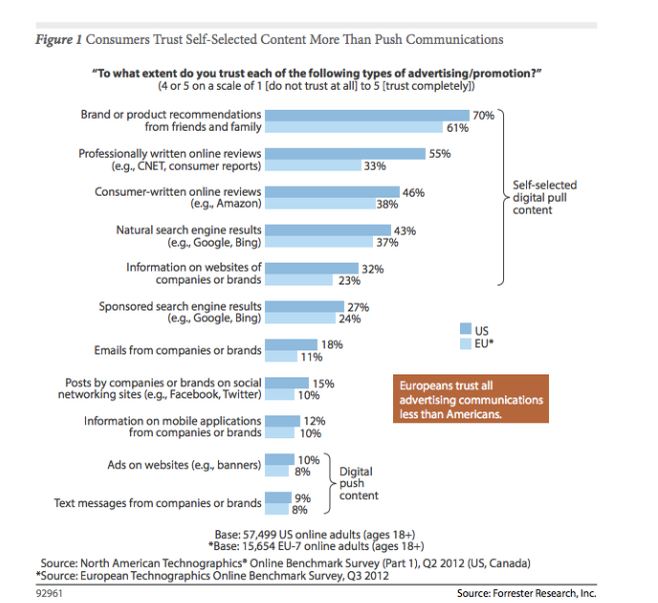Part of my role as a counselor to clients is keeping them up to speed on new online marketing research. I came across two reports last week that could be useful when evaluating client tactics.
The first was from Forrester Research and looked at what kind of content online consumers find most persuasive. Per the graphic above, content that Forrester calls “self-selected” is by far the most trusted content. This reflects what I call thinking “pull rather than push” in your online marketing. According to a quote in TechCrunch from report author Tracy Stokes:
”Today’s consumers decide where, when, and how they want to engage with brands. With multiple interconnected devices at their fingertips at any one time, these perpetually connected consumers can opt in or out of content as they choose… Marketers face a higher bar to engage consumers, who have more media options than ever before.”
Posts on social media sites scored very low on the Forrester scale, making me wonder exactly how B2C companies are trying to promote via social media. If they are trying to use social media as a new channel for advertising, then that ranking makes a lot of sense. Content promoted via social media cannot be viewed as advertising. The other question I have was how the survey categorized a recommendation from a friend or family — the most trusted content — if it came via social media.
Digital marketing software maker Optify provided a more B2B perspective in their 2012 Marketing Benchmark Report. It attempts to quantify sources of traffic to B2B sites. The key findings and takeaways are definitely worth a few minutes of your time. Here are a few key findings:
- Google is the referring URL for 36 % of all B2B visits, and 41% of Google traffic has the keyword blocked (this is due to the user being logged in while searching)
- Despite increased adoption, social media accounts for less than 5% of B2B traffic on average
- Email showed high reader engagement (3.75 pages per visit) and the highest conversion rate of 2.9%
- Facebook drives the most traffic of the “big three” social media platforms – Facebook, LinkedIn, Twitter — but Twitter is by far the best performer for leads, generating on average 82% of leads from social media
That last one was very surprising for me — LinkedIn drives the most traffic for most of my clients, and Twitter is almost never a main source of leads. This could be because most of my clients offer a higher priced product or service with a typically long sales cycle. But this nugget is good reason to review how my clients could be optimizing their Twitter strategies.
